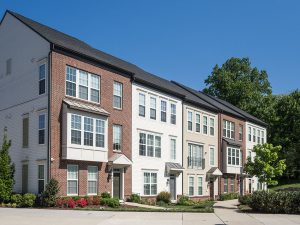An analysis of Montgomery County’s property assessment database over the past century shows homebuilding consistently increased before peaking in the 1980s and has since slowed substantially. The data also show how the composition of the housing stock has changed over time, from overwhelmingly single-family to many more townhouses and apartments.
From before the 1920s through the 1980s, each successive decade saw more homes built than the decade before, except for the 1970s. Then, starting in the 1990s, the trend reversed, with a sharp drop-off in new homes from the 1980s. The decline continued through 2019. Data for 2020 to 2022 suggest that the county may be on pace for another decade of decline.

A townhome development in Glenmont, Montgomery County.
The types of homes built in the county have also changed significantly over the last century. Through the 1950s, the county’s housing stock was comprised almost entirely of single-family homes, along with a small percentage of garden apartments. However, over time, single-family homes accounted for a smaller share of new units as other types became more prominent. Townhomes made up the largest share in the 1980s, peaking at 40% of new units over that decade. Meanwhile, high-rises (defined as buildings with five or more stories) have generated the most new housing units since the 2010s.
By the end of 2022, Montgomery County had no majority housing type, and the share of single-family detached homes had dropped to 48%. Because single-family homes are so land-intensive, their share inevitably declines in areas as they mature and bump up against geographic constraints. Even as early as the 1960s, it was clear Montgomery County needed other housing types to accommodate new residents.
Going forward, the county’s General Plan, Thrive Montgomery 2050, and Montgomery Planning’s Attainable Housing Strategies (AHS) initiative recognize that Montgomery County’s housing stock will continue to shift toward townhouses and multi-family housing; there is not enough land to meet the housing demand through single-family development alone. This is why AHS encourages additional housing types, such as triplexes and quadplexes (three and four units per structure). Only by providing a more diverse range of housing options can we meet the needs of all people and families who want to call Montgomery County home.
About the data
This analysis uses housing data from the Maryland State Department of Assessments and Taxation (SDAT) property database for Montgomery County. Dwelling-unit totals from SDAT are lower than U.S. Census housing unit totals due to different methodologies. Garden apartments are defined as four or fewer stories; high-rises are five or more stories.
It is important to note that the database excludes housing units that were demolished. If new units are rebuilt onsite, the build year is the year of new construction. This results in a minor discrepancy between current housing stock and historical building activity. About 5,000 single-family homes and 1,100 multi-family units were demolished through 2022, which amounts to about 3% and 1% of single-family and multi-family homes, respectively.

About the author
Benjamin Kraft is a research planner in Montgomery Planning’s Research and Strategic Projects Division. His research and planning work focus on topics related to the economy and employment. Ben has a Ph.D. in city and regional planning from Georgia Tech and a master’s degree in urban planning from the University of Michigan.